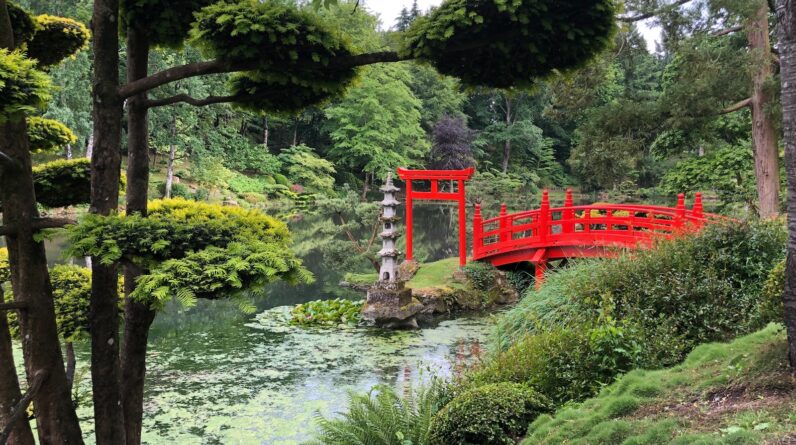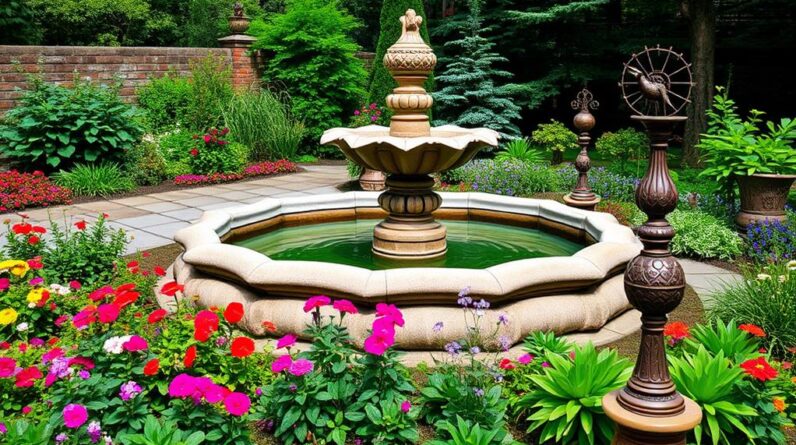
Imagine stepping into a tranquil oasis. You wander through a perfectly balanced landscape, surrounded by meticulously raked gravel and carefully placed rocks. Welcome to the world of Japanese Zen gardens.
In this article, we will delve into the history, philosophy, and design principles of these enchanting spaces. Discover the origins, explore the influences, and uncover the modern interpretations of Zen garden principles.
Get ready to embark on a journey of innovation and enlightenment.
Key Takeaways
- Japanese Zen gardens originated in the 8th century and were influenced by Chinese and Korean gardening traditions.
- They were created as spaces for meditation and contemplation within Buddhist temples and are designed to represent miniature landscapes.
- Zen garden design is rooted in simplicity, harmony, and mindfulness, emphasizing the appreciation of the present moment.
- Elements of Zen gardens include rocks, gravel, plants, and water features, with the incorporation of architectural structures like bridges and lanterns.
Origins of Japanese Zen Gardens
As you delve into the origins of Japanese Zen gardens, you’ll discover the rich history and cultural significance behind these tranquil spaces.
The roots of Zen gardens can be traced back to the 8th century, during the Heian period in Japan. Influenced by Chinese and Korean gardening traditions, Zen gardens were initially created as spaces for meditation and contemplation within Buddhist temples.
These gardens were designed to represent miniature landscapes, with carefully arranged rocks, gravel, and raked patterns symbolizing mountains, rivers, and waterfalls. The philosophy behind Zen gardens emphasizes simplicity, harmony, and the appreciation of natural beauty.
Over time, Zen gardens evolved to include elements such as moss, plants, and water features, while still maintaining their minimalist aesthetic.
Today, Japanese Zen gardens continue to inspire and captivate with their innovative design principles and serene atmospheres.
The Philosophy Behind Zen Garden Design
You’ll discover that the philosophy behind Zen garden design is rooted in simplicity and harmony. Japanese Zen gardens, also known as dry landscape gardens or rock gardens, are meticulously designed spaces that aim to create a sense of calm and tranquility.
The design principles of these gardens are deeply influenced by Zen Buddhism, which emphasizes mindfulness and the appreciation of the present moment. The simplicity of Zen garden design is evident in its minimalistic approach, using only a few carefully chosen elements such as rocks, gravel, and sometimes moss.
These elements are arranged in a way that evokes natural landscapes, such as mountains, islands, or rivers. The harmony in Zen garden design is achieved through the careful balance of these elements, creating a sense of unity and serenity.
Elements and Features of Zen Gardens
By incorporating various natural elements and carefully arranging them, you can create a Zen garden that embodies tranquility and balance. Zen gardens typically consist of specific elements and features that contribute to their unique aesthetic and spiritual atmosphere. These elements are meticulously chosen and placed to evoke a sense of harmony and serenity.
One of the key features of a Zen garden is the use of rocks or stones. These are strategically positioned to represent mountains or islands and symbolize stability and permanence. Additionally, sand or gravel is often used to create ripples or patterns, symbolizing water and creating a calming effect.
Another essential element is the presence of plants, particularly evergreens such as pine trees and bamboo. These plants symbolize longevity and resilience, adding a touch of greenery and life to the garden.
Furthermore, Zen gardens often incorporate architectural features such as bridges, lanterns, and pavilions. These structures serve both practical and aesthetic purposes, providing focal points and enhancing the overall design.
The following table provides a summary of the key elements and features commonly found in Zen gardens:
| Element/Feature | Description |
|---|---|
| Rocks/Stones | Symbolize stability and permanence |
| Sand/Gravel | Create ripples or patterns, symbolize water |
| Plants | Evergreens, symbolize longevity and resilience |
| Bridges | Provide focal points and add depth |
| Lanterns | Enhance the atmosphere and provide lighting |
| Pavilions | Serve as resting places and meditation spaces |
Historical Influences on Zen Garden Design
To understand the historical influences on Zen garden design, you’ll explore the origins and evolution of these serene and contemplative spaces. Here are three key historical influences that have shaped the design principles of Zen gardens:
- Chinese Gardens: Zen gardens have their roots in the Chinese tradition of creating harmonious landscapes that reflect the balance between man and nature. These gardens often featured rocks, water, and plants arranged in a way that evoked a sense of tranquility and simplicity.
- Zen Buddhism: Zen gardens emerged in Japan during the Kamakura period (1185-1333) as a reflection of Zen Buddhism’s emphasis on meditation and mindfulness. The gardens were designed to provide a peaceful environment for contemplation and self-reflection.
- Wabi-Sabi Aesthetic: The concept of wabi-sabi, embracing imperfection and transience, greatly influenced Zen garden design. This aesthetic value placed importance on natural materials, asymmetry, and simplicity, creating a sense of beauty that’s raw and unpretentious.
Modern Interpretations of Zen Garden Principles
As you delve into modern interpretations of Zen garden principles, it’s important to consider how designers have adapted traditional concepts to create contemporary and unique expressions of tranquility and harmony.
In today’s fast-paced world, where innovation and creativity are highly valued, designers have taken the fundamental principles of Zen gardens and infused them with new ideas, materials, and techniques. The focus remains on creating a space that promotes mindfulness, contemplation, and a sense of calm, but the interpretation of these principles has become more flexible and experimental.
Modern Zen gardens may incorporate elements such as minimalist design, unconventional materials, and interactive features, all while maintaining the serene and balanced atmosphere that’s essential to the Zen philosophy. These contemporary interpretations not only showcase the adaptability of Zen garden principles but also provide a fresh and innovative approach to creating spaces of tranquility in our modern lives.
Frequently Asked Questions
Are Zen Gardens Only Found in Japan?
Yes, zen gardens are not only found in Japan. They have gained popularity worldwide due to their calming and meditative qualities. Many countries have embraced the concept and created their own versions of zen gardens.
What Is the Purpose of the Raked Gravel in Zen Gardens?
The purpose of the raked gravel in Zen gardens is to create a sense of tranquility and mindfulness. By raking the gravel in precise patterns, you can engage in a meditative practice that promotes inner peace and focus.
Are There Any Specific Plants or Flowers That Are Commonly Used in Zen Gardens?
In Japanese Zen gardens, specific plants and flowers are commonly used to enhance the tranquil atmosphere. These selections often include evergreens, moss, bamboo, and cherry blossoms, all carefully chosen to embody the principles of simplicity, harmony, and natural beauty.
Can Anyone Create a Zen Garden, or Is It a Specialized Skill?
You can create a Zen garden regardless of your skills. It’s a personal journey that requires patience and mindfulness. By understanding the principles and philosophy, you can bring tranquility and harmony to your space.
How Do Zen Gardens Contribute to Mindfulness and Meditation Practices?
To truly delve into mindfulness and meditation, consider how Zen gardens contribute. Their carefully arranged rocks, raked sand, and flowing water symbolize the journey towards inner peace, guiding you towards a state of calm and self-reflection.












